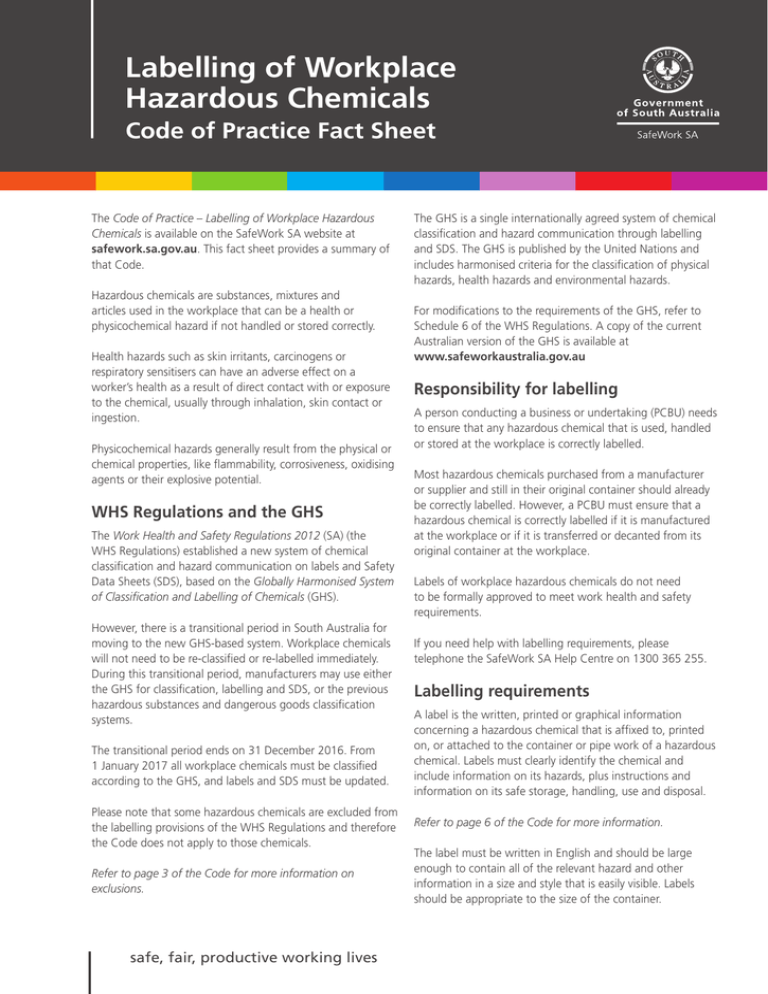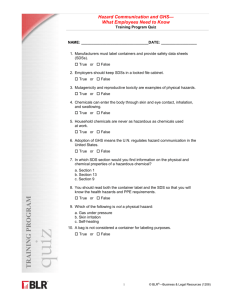Labelling of Workplace Hazardous Chemicals
advertisement

Labelling of Workplace Hazardous Chemicals Code of Practice Fact Sheet The Code of Practice – Labelling of Workplace Hazardous Chemicals is available on the SafeWork SA website at safework.sa.gov.au. This fact sheet provides a summary of that Code. Hazardous chemicals are substances, mixtures and articles used in the workplace that can be a health or physicochemical hazard if not handled or stored correctly. Health hazards such as skin irritants, carcinogens or respiratory sensitisers can have an adverse effect on a worker’s health as a result of direct contact with or exposure to the chemical, usually through inhalation, skin contact or ingestion. Physicochemical hazards generally result from the physical or chemical properties, like flammability, corrosiveness, oxidising agents or their explosive potential. WHS Regulations and the GHS The Work Health and Safety Regulations 2012 (SA) (the WHS Regulations) established a new system of chemical classification and hazard communication on labels and Safety Data Sheets (SDS), based on the Globally Harmonised System of Classification and Labelling of Chemicals (GHS). However, there is a transitional period in South Australia for moving to the new GHS-based system. Workplace chemicals will not need to be re-classified or re-labelled immediately. During this transitional period, manufacturers may use either the GHS for classification, labelling and SDS, or the previous hazardous substances and dangerous goods classification systems. The transitional period ends on 31 December 2016. From 1 January 2017 all workplace chemicals must be classified according to the GHS, and labels and SDS must be updated. Please note that some hazardous chemicals are excluded from the labelling provisions of the WHS Regulations and therefore the Code does not apply to those chemicals. Refer to page 3 of the Code for more information on exclusions. safe, fair, productive working lives The GHS is a single internationally agreed system of chemical classification and hazard communication through labelling and SDS. The GHS is published by the United Nations and includes harmonised criteria for the classification of physical hazards, health hazards and environmental hazards. For modifications to the requirements of the GHS, refer to Schedule 6 of the WHS Regulations. A copy of the current Australian version of the GHS is available at www.safeworkaustralia.gov.au Responsibility for labelling A person conducting a business or undertaking (PCBU) needs to ensure that any hazardous chemical that is used, handled or stored at the workplace is correctly labelled. Most hazardous chemicals purchased from a manufacturer or supplier and still in their original container should already be correctly labelled. However, a PCBU must ensure that a hazardous chemical is correctly labelled if it is manufactured at the workplace or if it is transferred or decanted from its original container at the workplace. Labels of workplace hazardous chemicals do not need to be formally approved to meet work health and safety requirements. If you need help with labelling requirements, please telephone the SafeWork SA Help Centre on 1300 365 255. Labelling requirements A label is the written, printed or graphical information concerning a hazardous chemical that is affixed to, printed on, or attached to the container or pipe work of a hazardous chemical. Labels must clearly identify the chemical and include information on its hazards, plus instructions and information on its safe storage, handling, use and disposal. Refer to page 6 of the Code for more information. The label must be written in English and should be large enough to contain all of the relevant hazard and other information in a size and style that is easily visible. Labels should be appropriate to the size of the container. The label must be attached to the outside of the container and should be visible in the normal storage position. The information and any symbols on the label should be printed in a colour or colours that provide a distinct contrast to the background colour. Refer to page 20 of the Code for more information. Reviewing labels Labels must be reviewed periodically in order to ensure they are up-to-date e.g. when there is a change in the formulation or ingredients that changes the hazardous properties of the chemical, or when new information on the hazards of the product or any of its ingredients becomes available. When the classification of a hazardous chemical changes the label must be reviewed and, if necessary, revised to reflect any changes. Importers, manufacturers and suppliers should review any new or significant information regarding any hazardous chemicals they import, manufacture or supply. A review of the literature and other relevant sources of information should be undertaken on a regular basis, but at least every five years. © Government of South Australia, 2014 | 0889-10-2 OCTOBER 2014 safe, fair, productive working lives 1300 365 255 safework.sa.gov.au This publication is licensed under a Creative Commons Attribution Australia Licence v3.0. For terms see: http://creativecommons.org/licences/by/3.0/au/deeden. Disclaimer | While care has been taken to ensure the accuracy and currency of the information in this publication, at the time of reading it may not be sufficiently accurate, current or complete to suit your individual needs. Reliance on the information in this publication is at your own risk. SafeWork SA accepts no liability for any loss resulting from your reliance on it. To best meet your work health and safety obligations refer to current Acts, Regulations and Codes of Practice.

